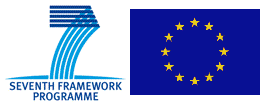EICS 2011 – Industrial Panel on Research Agenda in Service Front Ends
EICS 2011 was the third edition of an international conference devoted to the engineering of usable and effective interactive computing systems. EICS focuses on methods and techniques, and the tools that support designing and developing interactive systems. An industrial panel at this conference stimulated more interactions between the EICS community and the industry.
The panel’s coordinator was Fabio Paternò, who introduced key topics for the panelists to discuss, such as: user experience; ubiquitous support; and social computing. Five panelists presented their perspectives about these topics, and their main ideas are briefly presented below:
- Stephane Chatty introduced the problem of how to design for User eXperience at a reasonable cost, highlighting the age-old tension between pursuing UX while keeping low costs. He also highlighted the fact that interaction designers have a key role in UX, and that more specialised SFEs in the future will be necessary.
- Mauro Cherubini pointed out two main aspects: one is the fact that nowadays the 90% of the mobile phones in the world are NOT smartphones, but are just feature phones. Therefore the idea that everyone will have a smartphone in the next few years is NOT coming to happen because there is a cost barrier. The second idea is the fact that telcos are not just “dumb pipes”. Indeed, Telefonica has recently released BluVIA, which are APIs for the developers, that will enable them to use the telco infrastructure. For instance, by using BluVIA, people are enabled, with a feature phone, to send twitting messages.
- <
Get Juicy Cleanse – Lose Up To 10 Pounds In Ten Days
strong>Bettina Laugwitz remarked that the focus should be on: adaptivity (e.g. adaptation based on the level of expertise), need of proactive support in information access (e.g. by providing intelligent hints), context-awareness (especially as far as physical environment is concerned) and support the user productivity by also enhancing user satisfaction.
- Carlos Alberto Licciardi highlighted some aspects that characterise the current device market: fragmentation of devices, the existence of several OS/interaction patterns/customisations/capabilities and APIs and the fact that a short time to market is a must. Therefore we would need ubiquitous access from several devices, by supplying a single backend for several front ends (develop once and run everywhere). Possible solutions for this scenario can be either to develop only browser-based applications, or use some technology (like HTML5+W3C DAP) that is currently available and can be used for this goal.
- Dave Raggett identified some challenges for the development of effective SFEs: customer-centred design for effective web sites, rapidly changing fashions for website designs, distribute development teams, responding to urgent calls for changes, wide ranges of screen sizes, new interaction mechanisms, browser-interoperability issues. In addition, he also focuses on design patterns as a basis for shared insights and also the opportunity of classifying, choosing and combining patterns.
Further information can be accessed in the original article, published at: http://eics-conference.org/2011/EICS_2011-industrial_panel.pdf
zp8497586rq
If you enjoyed this article, please consider sharing it!





-
Twitter
- No public Twitter messages.
-
All about Serenoa
-
Funded by the European Commission

-
tags
Adaptation adaptive UI ambient intelligence Android Android SDK browser Brussels CASFE conference consortium context context-aware adaptation context-awareness CSS E-book Reader EICS elderly Events Facebook Fragments API framework HTML5 industrial panel iPad journal LREC MBUI Meeting Mobile Mobile Apps Model-driven models newsletter paper presentation review Review Meeting Serenoa standardization touch-based interaction TV UI W3C Working Group workshop



